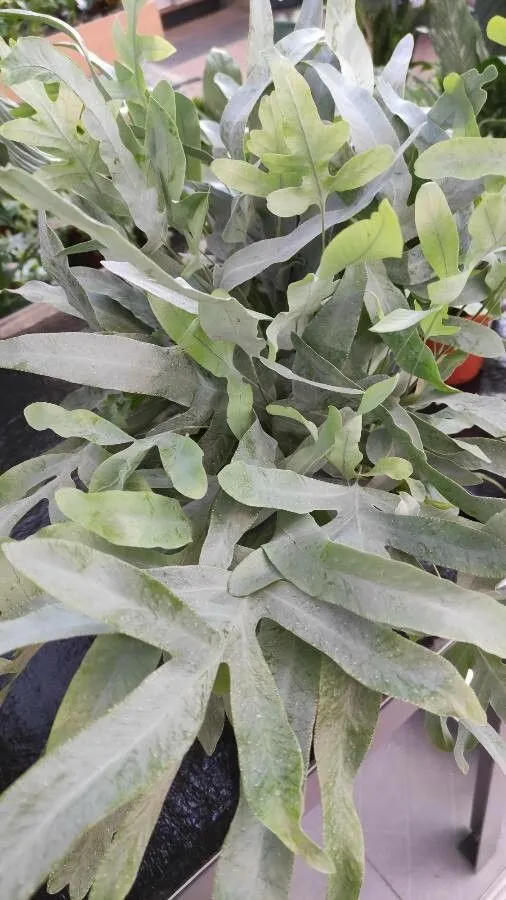
Author: (L.) J.Sm.
Bibliography: J. Bot. (Hooker) 4: 59 (1841)
Year: 1841
Status: accepted
Rank: species
Genus: Phlebodium
Vegetable: False
Observations: SE. U.S.A., Caribbean to S. Trop. America
The Golden Polypody, scientifically known as Phlebodium aureum, is a vibrant fern that thrives in a range of habitats from the southeastern United States, extending through the Caribbean, and reaching into southern tropical America. Described by esteemed botanist (L.) J.Sm. and documented in J. Bot. (Hooker) 4: 59 in 1841, this striking plant belongs to the Polypodiaceae family, which is renowned for its diverse and robust ferns.
This fern is recognized for its glossy, golden-green fronds that can add a touch of natural elegance to any environment. Known for their resilience, the fronds of the Golden Polypody can exhibit an almost shimmering quality in the sunlight, hence the name ‘golden’. The plant’s rhizomes, creeping beneath the surface, are covered in scales, contributing to its robust nature and ability to anchor itself on various surfaces, from forest floors to tree trunks.
Golden Polypodies tend to prefer humid, shaded environments, reflecting their native range’s subtropical and tropical climates. This makes them particularly well-suited to greenhouse cultivation or as part of indoor plant collections where they can be provided with controlled humidity and indirect light. However, they are also hardy enough to adapt to a variety of growing conditions, making them a popular choice for both experienced and novice gardeners.
Their natural habitat in regions ranging from the Southeastern U.S.A. to the varied landscapes of the Caribbean and South Tropical America means that Golden Polypodies often grow in symbiosis with other flora, contributing to the biodiversity and ecological richness of their environments. Their presence not only adds aesthetic value but also plays a role in the ecosystem by providing cover and moisture retention on the forest floor.
In summary, the Golden Polypody (Phlebodium aureum) is a stunning and versatile fern hailing from the diverse regions of southeastern North America, the Caribbean, and southern tropical America. Its lush, golden-hued fronds and hardy nature make it a beloved plant for both natural habitats and cultivated spaces alike.
Spa: calaguala
Eng: gold-foot fern, golden polypody, hare-foot fern, rabbit-foot fern
Deu: goldtüpfelfarn
Swe: hartassbräken
En: Golden polypody, Gold-foot fern, Rabbit-foot fern, Hare-foot fern, Cabbage palm fern
Bg: Златист флебодиум
Fi: Kultaimarre
De: Goldtüpfelfarn
Pl: Flebodium złociste
Ru: Флебодиум золотистый
Es: Calaguala
Sv: Hartassbräken
Taken Jul 1, 2021 by Paul Sullivan (cc-by-sa)
Taken Jan 14, 2021 by Cait Pezza (cc-by-sa)
Taken May 4, 2017 by Rémi Knaff (cc-by-sa)
Taken May 4, 2017 by Rémi Knaff (cc-by-sa)
Taken May 4, 2017 by Rémi Knaff (cc-by-sa)
© copyright of the Board of Trustees of the Royal Botanic Gardens, Kew.
© copyright of the Board of Trustees of the Royal Botanic Gardens, Kew.
© copyright of the Board of Trustees of the Royal Botanic Gardens, Kew.
Taken May 4, 2017 by Rémi Knaff (cc-by-sa)
Taken Jan 1, 1900 by EOL − Derek Ramsey (Ram-Man). Location credit to the Chanticleer Garden. (cc-by-sa)
Taken May 4, 2017 by Rémi Knaff (cc-by-sa)
Taken May 4, 2017 by Rémi Knaff (cc-by-sa)
Taken Jan 11, 2022 by Dieter Albrecht (cc-by-sa)
Taken Dec 16, 2021 by Collados Ana (cc-by-sa)
Taken Jun 1, 2021 by aja (cc-by-sa)
Taken Apr 19, 2022 by manuseitz (cc-by-sa)
Taken Sep 23, 2022 by William Coville (cc-by-sa)
Taken May 4, 2017 by Rémi Knaff (cc-by-sa)
Taken May 4, 2017 by Rémi Knaff (cc-by-sa)
Taken May 4, 2017 by Rémi Knaff (cc-by-sa)
Taken May 4, 2017 by Rémi Knaff (cc-by-sa)
Taken May 4, 2017 by Rémi Knaff (cc-by-sa)
Taken Nov 5, 2021 by robert Woszak (cc-by-sa)
Taken Aug 13, 2021 by Cécile Ttx (cc-by-sa)
Taken May 4, 2017 by Rémi Knaff (cc-by-sa)
Taken Jul 6, 2020 by Teo Manta (cc-by-sa)
Taken Oct 9, 2021 by Gina jax (cc-by-sa)
Growth habit>: Forb/herb
Family: Myrtaceae Author: (F.Muell.) K.D.Hill & L.A.S.Johnson Bibliography: Telopea 6: 402 (1995) Year: 1995 Status:…
Family: Rubiaceae Author: Pierre ex A.Froehner Bibliography: Notizbl. Bot. Gart. Berlin-Dahlem 1: 237 (1897) Year:…
Family: Sapindaceae Author: Koidz. Bibliography: J. Coll. Sci. Imp. Univ. Tokyo 32(1): 38 (1911) Year:…
Family: Asteraceae Author: A.Gray Bibliography: Pacif. Railr. Rep.: 107 (1857) Year: 1857 Status: accepted Rank:…
Family: Fabaceae Author: Medik. Bibliography: Vorles. Churpfälz. Phys.-Ökon. Ges. 2: 398 (1787) Year: 1787 Status:…
Family: Aspleniaceae Author: (Cav.) Alston Bibliography: Bull. Misc. Inform. Kew 1932: 309 (1932) Year: 1932…